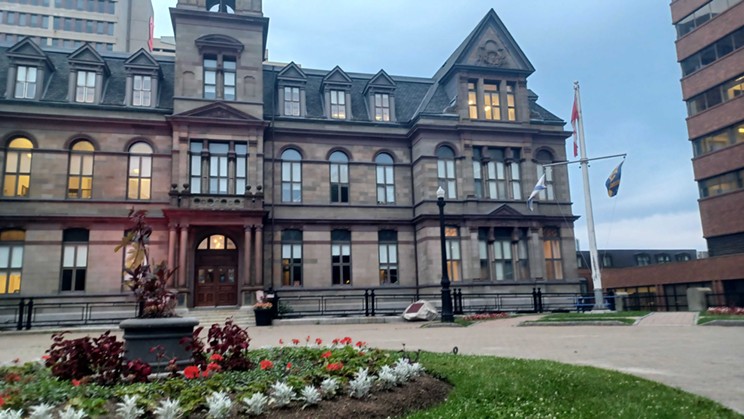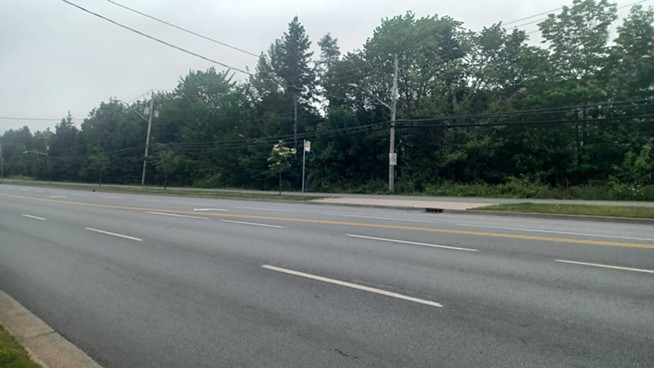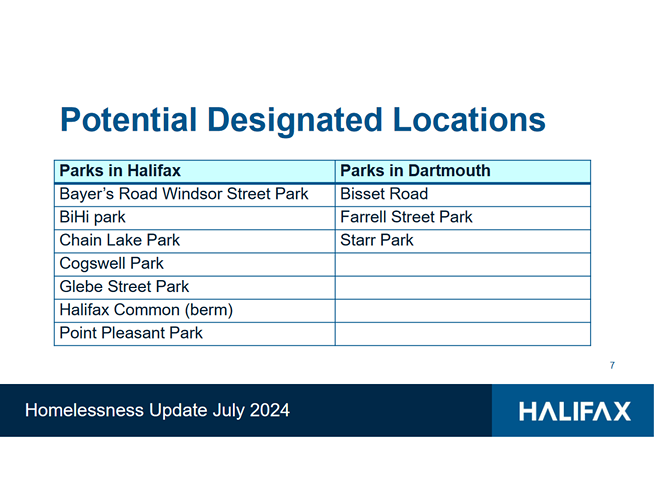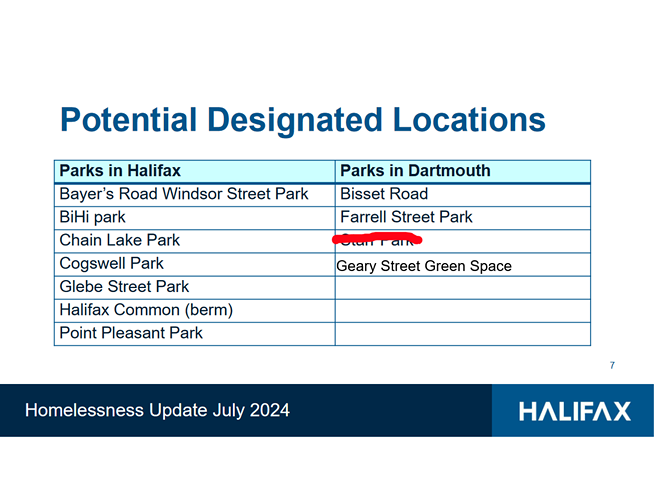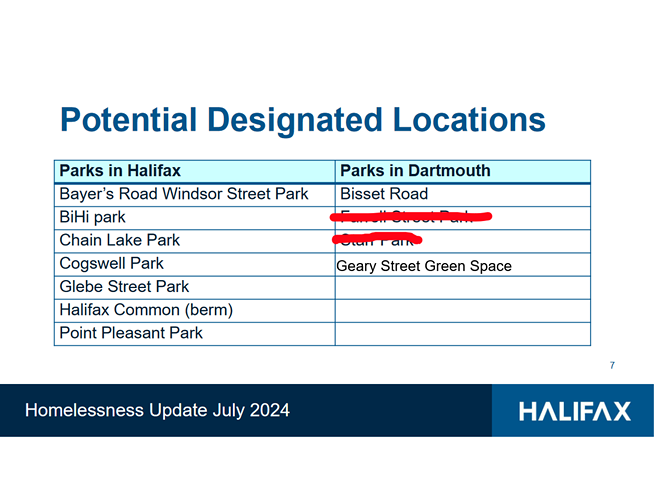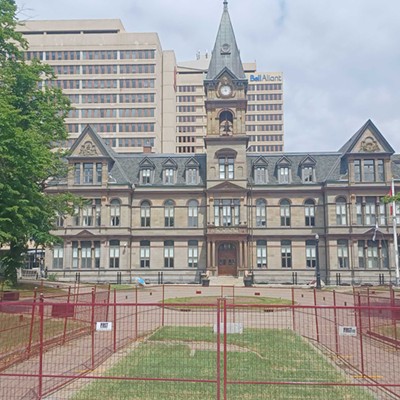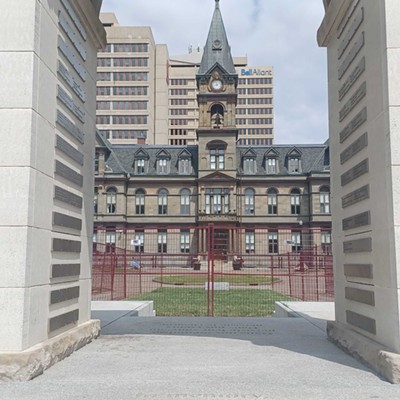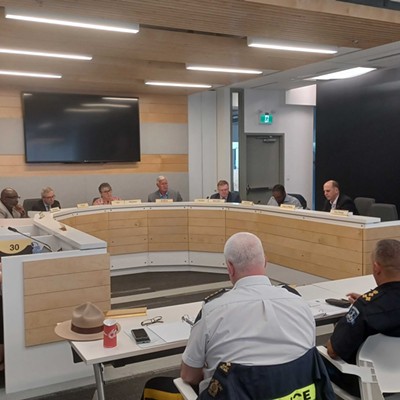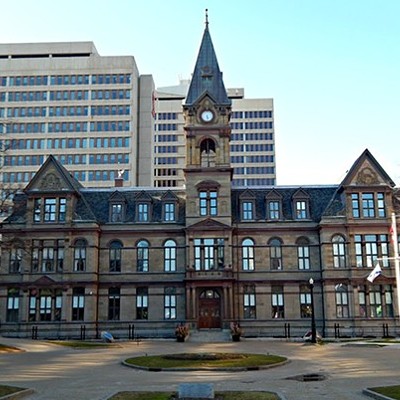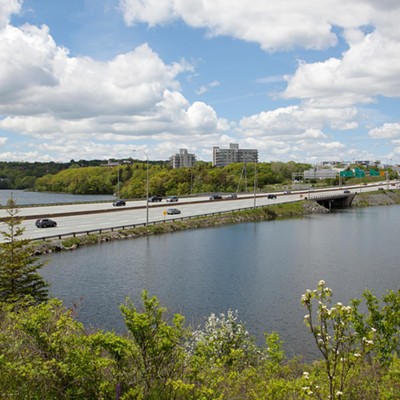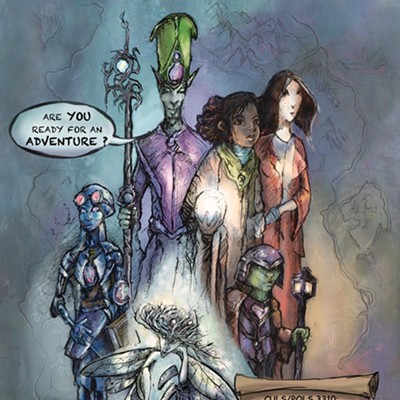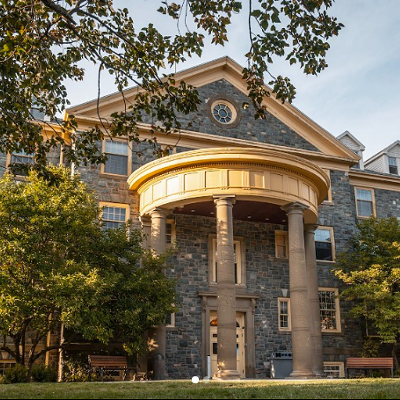In the name of road safety, urged on by “professional” traffic engineers, Halifax’s city council have approved a little bit of social murder. Social murder is a bit of an old concept first defined by Friedrich Engles in 1844 in his book The Condition of the Working Class in England and more recently reported on in the article This City Kills Children written by Greg Opperman for Worcester Sucks and I love it. Engles defined social murder like this:
When one individual inflicts bodily injury upon another such that death results, we call the deed manslaughter; when the assailant knew in advance that the injury would be fatal, we call his deed murder. But when society places hundreds of proletarians in such a position that they inevitably meet a too early and an unnatural death, one which is quite as much a death by violence as that by the sword or bullet; when it deprives thousands of the necessaries of life, places them under conditions in which they cannot live – forces them, through the strong arm of the law, to remain in such conditions until that death ensues which is the inevitable consequence – knows that these thousands of victims must perish, and yet permits these conditions to remain, its deed is murder just as surely as the deed of the single individual.
Social murder is practiced in modernity by most if not all large multinational companies, and in some professional organizations, like Engineers Nova Scotia, the professional association of engineers that Halifax’s traffic engineers like Lucas Pitts and Roddy MacIntyre belong to. Engineers Nova Scotia’s bylaws section 24(1) read: “Members, persons licensed to practice and engineers-in-training shall conduct themselves in accordance with the Code of Ethics appended hereto, and without restricting the meaning of unprofessional conduct, any breach of the Code of Ethics shall be deemed to be a form of unprofessional conduct.”
And the code of ethics in question clause number 1 reads, “Hold paramount the safety, health and welfare of the public and the protection of the environment and promote health and safety within the workplace.” Which in layman's terms means don’t do social murder.
In spite of that, at this council meeting Halifax’s traffic engineers proposed that in order to make streets safer we should add dedicated turn lanes for cars writing, “On-going implementation of fully protected turns will be based on need, where it is determined these measures can be reasonably applied without significant detrimental impacts to operations resulting in the creation of other safety issues and where substantial infrastructure requirements are not needed.”
Ignoring for a moment that this protected turn report was supposed to be its own staff report examining the dangers of providing cars with a dedicated opportunity to plow through pedestrians. And not ignoring—but conscious of word count and modern attention spans—that designing infrastructure to expedite car traffic doesn’t help alleviate congestion and that infrastructure is more likely to kill people when car volumes are lower. But this recommendation is supposed to make Halifax’s road safer because this is in support of Halifax’s “evidence based” “systems level” approach to road safety.
According to the American Federal Highway Administration’s 254-page meta-analysis of protected turn lane studies, they found that there is a slight safety decrease in driver on driver car violence, and that left turn lanes add safety primarily in rural highway settings. However, it should be noted that of the studies that showed a drastic increase in safety most were also modeling studies, not real world ones. Studies that looked at the effects of adding turn lanes “found that left-turn lanes were associated with higher frequencies of both total multiple-vehicle accidents and fatal and injury multiple-vehicle accidents.” With other studies finding that left turn lanes increased right angle collisions, increased all collisions or that turn lanes didn’t affect collision rates at all.
In short, Halifax city staff want to give cars protected left hand turn phases, when the meta-analysis suggests that even having protected turn lanes might not even be that safe. Protected turn movements for cars are part of a road safety plan in the same way Froot Loops are part of a balanced breakfast. There is no real evidence to suggest that staff’s first suggestion under this new evidence-based plan is in fact based on evidence.
On top of that, have you noticed recently that more and more people are running red lights? I’m not talking about the red runners that blow through a straight red, I’m talking about the lemmings that follow the cars turning left until the drivers waiting at the cross street green get impatient. Or worse, the folks that keep turning left on the little green arrow even after all of the lights have turned green and the white man in the pedestrian sign says walk? If you haven’t, you will now. It’s particularly egregious on Saturday afternoons when cars keep turning left off Bell Road onto Sackville Street long after the green arrow is extinguished. Socially murderous drivers speed up into their left-hand turn even as hordes of Wanderers fans step off into the intersection. Dedicated turn lanes increase the odds that drivers will be in conflict with—aka hit—people who are not in cars. On top of that, if those drivers are driving new cars, those cars are way more likely to kill a pedestrian than cars of old. If our new road safety framework was in fact a systems level approach to road safety, the suggestion to increase the ease of throughput of lethal cars while increasing potential for fatal driver vs. non-driver conflicts would have never been made to council.
Essentially the very first suggestion from staff to council under the new road safety framework is a suggestion to increase social murder. While there is a lot that is confusing, angering or disparaging about this trend in road safety planning in the HRM, the most perplexing is why Engineering Nova Scotia continues to allow traffic engineers to publicly flaunt the bylaws of their organization while disrespecting the engineering code of ethics and bring disrepute to the profession of engineering as a whole. Are the people of Engineers Nova Scotia not embarrassed by the engineering charlatans who socially murder in the name of saving a few seconds off a commute time instead of not doing that and saving lives instead?
Things that passed
Deferred from last meeting the Events East business plan is up for approval from council. For the low low price of $2.1 million the HRM can help Events East generate an estimated $60 million in “Direct Expenditures” which primarily benefits the provincial budget. This passed.
Deputy mayor Cathy Deagle Gammon brought forward an information item about road closures for construction. This was brought forward as a true information item by Deagle Gammon. The recent construction closures of Waverly Road were painful for residents, but the city learned some lessons and she just wanted to let everyone, but specifically people on Waverly Road, know that this short notice on road closures should not happen again.
Council will consider amending the Municipal Planning Strategy and Land Use Bylaws for a development in Upper Tantallon. The property owner wants to put a mixed-use apartment building at 5249 St. Margarets Bay Rd., but even though the city has a very popular 2014 plan to turn Upper Tantallon into a “Tantallon Crossroads Coastal Village” (aka complete community) the MPS and LUBs have not yet been amended to allow that type of development. This passed first reading and will now get a staff report.
When the province started charging Airbnbs the hotel tax a bunch of landlords didn’t do their homework and caught some fines for not declaring they had no taxes to pay. Because council’s favourite class of constituents was being negatively affected by their own negligence, council sprung into action and removed that administrative burden in four months. We are still waiting, and have been for years, for the city to fix the administrative burden placed on the poor who are getting means tested out of accessing rec programs. Airbnb has started charging the marketing levy on the app ahead of the bylaw changes coming into effect in September. Councillor Sam Austin asked staff about this, but they had no additional information, as they just learned about this change to the app too. But this passed so the bylaws have been amended and no more fines for short-term rental landlords improperly doing paperwork.
Councillor Kathryn Morse put forward a motion a while back to see if the HRM could better deal with dog attacks by having a municipal board to adjudicate dog attacks or increase the fines. This report came back to council and as it turns out the city averages less than one dog attack a week so standing up an administrative body isn’t really worth it, and higher fines don’t seem to affect dog attack frequency. It’s almost like fines aren’t a real deterrent to human behaviour and our silly rules and fines don’t matter to dogs who, and this is true, can’t read bylaws. Morse asked that her peers vote this down and instead ask for a staff report to increase the fines for dog attacks, especially for dogs who savagely attack. Councillor Becky Kent was watching from home and texted councillor David Hensdbee who read her remarks. Kent pointed out that the city increased fees on illegal dumping to try and curb that behaviour, so shouldn't we do the same for dogs that savagely attack? Counterpoint, drivers regularly savagely run down pedestrians but we don’t feel the need to jack up the consequences to punish that. Some violence we are more than happy to accept. During the debate, councillor Trish Purdy was aghast at the prevalence of dog attack violence, the good news here is that the HRM knows how to deal with something that is inherently violent. All we have to do is create a dashboard with dog bite data, change our dog bite metrics from absolute to per capita and then we can call it a public safety win. That’s how we made our roads safer. Staff have been tasked with writing a report to potentially increase the fines for dog attacks.
The city is changing the tax laws for the airport. Since the city started taxing the airport in the year 2000 the airport’s property has gone up in value from $89 million to $399 million, but the city has not been charging the airport property tax based on land value. City staff are recommending that we charge the airport $0.50 per passenger, up from $0.22 and would put us on par with the bustling metropolis of Thunder Bay. Ottawa charges $1.08 per passenger and Toronto charges $0.94. The new change is expected to net the city $2 million in revenue, but if we taxed the airport at Ottawa rates we’d get $3.9 million and if we charged the airport based on land value the city would net $8.6 million. If your councillor complains about not having enough municipal revenue (which your councillor does) and also votes to keep taxes low (which your councillor does) but then also accepts staff’s recommendation to continue under-taxing the airport then your councillor (if re-offering this fall) does not understand municipal revenues enough to warrant another term. This passed unanimously and without debate.
The memorial library, or maybe just the property, may see life again as a “public atrium, education space, HRM premises, commercial and retail space” at some point in the future. Even though the building looks cool from the outside, it’s been falling apart since the 1990s. Council’s going to hire some consultants to see what, if anything can become a reality for the building, or maybe just the property, in time for the 2025/26 capital budget. This passed with only Hendsbee voting no.
The micro-mobility pilot is continuing and staff are recommending some bylaw changes to make it easier. Also in this report, bikeshare is apparently coming to Halifax in 2025. This passed on consent.
The Mooseland & Area Community Association is trying to buy some land from the city and the city wants to sell this land to the community association. But due to the city’s punitive administrative burdens and the fact that this community association is run by volunteers, they need more time to jump through the city’s hoops. This passed on consent.
Because Halifax Transit’s costs are going up so too are the user fees! Transit tickets will be going up by 9.1% to a cool $3. As part of this debate councillor Hendsbee wanted to know if university Upasses could be used for express buses, staff told Hendsbee this could be easily done, but that’s not in the first draft of this legislation. After a brief debate about whether or not this needed a staff report, this suggestion was included in this legislation by striking out a word before passing first reading. It is now in the bylaw changes for when it comes back for second reading. Councillor Patty Cuttell pointed out that transit is a bit garbage out in her part of the city, so it feels cruel to raise the fare for subpar service without a plan to improve things. Speaking of cruel, the Forest Hills Parkway has a beautiful mixed use pathway next to a multi-lane road. On that mixed-use pathway it is common to see elderly Haligonians sitting on the ground on the path in the bicycle lane to shelter in the only nearby shade of a recently planted tree. Sometimes they are sitting on the ground of the concrete bus pad sweltering in the unshaded heat in the middle of a concrete heat island.
When the bus finally lumbers into view you can watch elderly Haligonians struggle to their feet, leaning heavily on their mobility aids, then shambling over to the bus. Such casual cruelty to our elders is part and parcel of Halifax Transit. This is likely one of the many reasons councillor Purdy spoke out against raising the fare, saying it was cruel to charge people more for this stellar municipal service. Without any hint of self-awareness, councillors spent some time blasting transit boss Dave Reage for council’s decision to starve Halifax Transit of money by keeping taxes (aka the mill rate) low earlier this year. This passed with councillors Purdy, Morse and Cuttell voting no.Here’s a fun fact about the automotive extremists that run the city. Even though the cost of operating our roads has gone up significantly, city staff have not seriously recommended a user fee increase for drivers. And the one time staff did recommend raising driving user fees by $2 on Saturdays and Sundays council shot that down pretty hard. And this past budget season staff recommended letting our roads degrade an additional 10% instead of recommending we charge more for parking to cover that budgetary shortfall. Later on, when we get to the new Road Safety Framework you should also think about the fact that Halifax now has a “systems level” approach to road safety. On a systems level, the danger in our transportation network comes from cars, and the best way to increase road safety is to decrease car traffic, which we can do by jacking up parking fees to disincentivize frivolous car trips. Will our city and council, who claim to be both “fiscally responsible” and “care about road safety” jack up parking fees? Unlikely. Why is that? Because this city doesn’t actually care about road safety and the new Road Safety Framework is the worst strategic plan I have ever seen. Just for some context, I was once involved in a strategic plan to go evacuate people from Libya by ship. We still followed this plan even though by the time we got there a week later, everyone had, predictably, already been evacuated by the use of a much faster transportation technology: Airplanes. As a result, the first few months of our deployment were spent twiddling our thumbs in the Mediterranean Sea because no one knew what to do with us when we got there. Still, that was more competent planning than demonstrated in the new Road Safety Framework.
After the transit debate council got an update on homelessness in the city. For some reason, as Canada inches closer to the second great depression, the city’s strategy of encampment whack-a-mole is not working. Here’s a fun fact about the Great Depression, compared to wages, the cost of living was far lower during the Great Depression. The price of a home was only about four times more than someone’s income. If Halifax were in the Great Depression today the average home price in Nova Scotia would be about $145,000 based on the average individual income of $36,400. The by name list, which is now over 1,300 people, continues to grow. The provincial promise of pallet shacks remains delayed. At the same time, the Grafton Street Park encampment in front of the old Memorial Library is growing and has about nine people, so the city has issued eviction notices. Meanwhile, over in Dartmouth, the Northbrook encampment has 13 people and they can’t be evicted because there’s no room to move the residents. If four more people move into the Memorial Library land it’s not clear that the city would remain in a legal eviction position. This is one of the many reasons why councillors were debating adding more parks to the official encampment list.
Councillors briefly debated not reopening Geary Street Green Space for tenting, but councillor Sam Austin pointed out that was the best of the worst decisions and the only reason council isn’t considering it now is because it’s already been de-designated and it would be embarrassing to revisit it. He pointed out that this whole debate is just revisiting council’s failures, so why wouldn’t they choose the best worst option? Just because it might be slightly more embarrassing than the debate they’re already having? He amended the motion to swap out Starr Park for Geary Street Green Space, this amendment passed with Savage as the only no vote.
Councillor Tony Mancini amended the motion to remove Farrell Street Park because they’ve already spent money cleaning it up and making it safe. Austin suggested using the green space beside the Highfield Park fire station to replace it but staff didn’t have all the information to say if it could be subbed in for Farrell Street. This amendment passed.
Councillor Paul Russell asked council to remove the Berm on the Halifax Commons and Point Pleasant Park from the list of potential sites; both votes failed. Staff will come back in November with an update on how these park sites are going because by then the province should have built out their promised pallet shacks. Purdy, Cuttell, Lovelace, Russell and Outhit voted against designating parks in the HRM. But the rest of this motion about updating encampment criteria and getting a follow-up report in November passed unanimously. More on this catastrophically depressing display of poor government in the notable debates section below.
Say what? Council is going to spend money improving the assisted hearing set up in Halifax’s council chambers.
Indigo Shores is likely to get an off leash dog park and a park plan, Soon™. This got pulled off the consent agenda so councillor Pam Lovelace could ask about the bacteria in Drain Lake and rail against car dependence before this passed unanimously.
The city of Halifax is updating its Solid Waste Management Strategy. Before the next budget, the city hopes to have an extended producer responsibility framework in place. If done well this legislation will incentivize companies in Halifax to not create garbage in the HRM, or make them pay for the garbage they generate. This should make Halifax a much nicer place to live, resulting in fewer Tim Hortons and McDonalds brand roadside beautification cylinders/cups. This was pulled off the consent agenda so that Cuttell could ask about the end of municipal recycling collection. Essentially this new strategy means that companies will be responsible for the garbage they make, including getting rid of it. If this happens as planned the city will no longer need to pick up recycling because it will be the responsibility of private companies who make the recyclable stuff instead. This may or may not actually happen, but if this does come to pass that the city no longer has to collect recyclables, it will happen in December 2025 because this passed.
Speaking of systemic solutions to problems, do you know what would also prevent garbage from ending up in the right of way, make our roads safer and help mitigate some of the worst effects of the on-going climate emergency? Banning drive-throughs. The good news is that we implemented a systems level approach to road safety later on in this meeting so the upcoming staff-generated report to do just that should come along to council in pretty short order. Unless, of course, our new Road Safety Strategy doesn’t work because it is the worst strategic plan I have ever seen.
The city’s going to write a letter supporting SolarBank’s community solar project.
The governance review phase 1 passed so RIP many useless advisory committees in the HRM. Also RIP to some important ones, more on this to follow in a future HFX Votes 2024 Grand Parade bonus episode. During the debate, councillor Austin amended the motion to ask staff to come back with a report to make a regional parks advisory board and this amendment passed. A staff report will come back at some point Soon™ about that. Councillor Tim Outhit amended this motion to ask for city staff to bring back advisory boards if/when the province reneges on the legislation that killed these committees in the first place. Twice amended this motion passed unanimously.
Council told the CAO to mail out voter cards for the fall municipal and CSAP elections.
Halifax’s Fire and Emergency Services is getting a bit of a reorganization. Some people will be moved from Fire to the new Department of Public Safety. The same people will be doing the same work, but now in a more appropriate chain of command for the work they are doing. This passed.
Halifax committed to making its streets no safer with the much-vaunted Road Safety Strategy: The Way Forward. During the debate, which was not much of a debate, councillor Waye Mason said that the Transportation Standing Committee sent it back to staff twice and staff did more consultation with stakeholders. The people who are supposed to be stakeholders told me that they were largely ignored by city staff, if city staff talked to them at all. Councillor Austin asked why we were using a per capita metric instead of the absolute numbers. The new head of the Department of Public Works (Congratulations! 🥳) Lucas Pitts explained that it was so we could compare ourselves to other cities. However, that’s not actually how we use per capita reporting because at the last Transportation Standing Committee meeting councillor Purdy asked why we couldn’t compare ourselves to Hoboken, New Jersey, who have prevented all deaths on their roads for the past seven years. Instead of saying he would use the flexibility provided by per capita reporting to compare ourselves to Hoboken and learn how we can do that too, Pitts instead said they were cheating. This terrible plan passed unanimously.
During that presentation to the Transportation Standing Committee where Pitts accused Hoboken of cheating he also probably lied through his teeth when he told that committee that this new plan was a “systems level approach” to road safety, because this plan is decidedly not that. In very simple terms what makes our transportation system dangerous is physics and probability. In the realm of physics, this equation is as follows: Mass of a car + speed of car travel = broken human bodies. In the realm of probability as car traffic increases, which it has year over year, then there are more chances for heavy fast cars to destroy a human life. The only way to make our system safer is to remove cars from it, decrease the speed at which they travel, or both. Since this new strategy passed, if you want to play along at home, here’s how you can determine if the “small group of road safety program engineers within the Public Works business unit” are competent professionals or snake oil salesmen of the highest order.
In the near future the Windsor Street Exchange 60% design will come back to council for approval. When it came back as a 30% design last council meeting, city staff told councillors that they prioritized making our transportation system more dangerous by planning to increase car traffic by 12%. Or in staff’s words, they planned to increase the “level of service” for cars instead of prioritizing dedicated continuous bus lanes or bike lanes. Now that the new road safety framework is in place, we can expect the city staff to abandon car-centric level of service analysis from all future planning as increasing the level of service for cars makes our transportation system more dangerous. As a result, this should free up staff to follow council’s instructions to prioritize buses, bikes and pedestrians in the 60% design of Windsor Street Exchange. Unless, of course, our new Road Safety Strategy doesn’t work because it is the worst strategic plan I have ever seen.
Colby Village Drive has traffic islands that everyone hates and that aren’t really slowing anyone down. At the last Transportation Standing Committee meeting staff initially recommended adding speed humps to the traffic islands, removing the traffic islands and replacing them with speed humps or removing everything. This was flatly panned by the Transportation Standing Committee and staff will come back to the committee with a new plan at a later date. Now that we have a new Road Safety Framework, part of a systems level approach to safety should be removing car trips by adding safe, convenient non-car alternatives to incentivize and encourage travel via non-car personal or public vehicles. Based on Colby Village Drive’s bus route and its integral connection to the bike infrastructure HRM recently built (as one would assume that city staff are planning for people to use the infrastructure the HRM builds) staff should come back with a recommendation to remove traffic calming, narrow the car lanes to 2.55 metres, ban on-street parking and make it a tow-away zone so buses can always get through. They will also add a bike lane or a mixed-use pathway to connect the existing and planned MUPs on Caldwell and Forest Hills Parkway and to the Saltmarsh and Portland trail networks. Unless, of course, our new Road Safety Strategy doesn’t work because it is the worst strategic plan I have ever seen.
Councillor Shawn Cleary recently directed staff to pull a Paris and come up with permit parking fees that are expensive and get more expensive based on the size and weight of vehicles. This is the easiest alley-oop a councillor could give to staff with a newly minted systems level approach to road safety, and staff should come back with prohibitively expensive parking permit fees for trucks and SUVs. And they will. Unless, of course, our new Road Safety Strategy doesn’t work because it is the worst strategic plan I have ever seen.
Moving on.
Just kidding, as part of the new road safety strategy staff have suggested a little bit of social murder as their first plan to make roads safer. They’re going to improve 10 intersections. As part of this report they’re also suggesting protected turn movements for car drivers be included to make things safer. Because as we all know, the best way to defeat cancer is to make it easier for that cancer to travel around your body. Sure slowing down cancer will likely limit its spread, but limiting the spread of cancer might make the cancer mad. Still, staff are deciding to try and appease the cancer of car traffic, which kills on average 15 Haligonians a year in the past five years, because our new Road Safety Strategy doesn’t work.
Have I mentioned it is the worst strategic plan I have ever seen?
Somebody needs to be held accountable for this failure. It didn’t happen during this council because they also passed this unanimously.
Shubenacadie Waterway is likely to become a Heritage River System by 2027 with the paperwork council endorsed.
Rural Transit needs more money and it’ll get an additional $500,000 in funding from the city. There was some debate about this as rural councillors took issue with the staff report which says: “These service providers offer an efficient, cost-effective form of public transportation in communities outside of Halifax Transit’s service area,” because that’s not a true statement. While it is cost-effective service delivery from a municipal budget point of view which will clock in at about $800,000 after this increase comes into effect—which is roughly equivalent to six police officers or eight kilometres of road paving—it is an expensive service to hire. Lovelace said members of her district are spending $150 on fares for a single trip to the doctor. If only Lovelace knew anyone who could increase the mill rate to help alleviate this problem. Ah well.
Council approved $150,000 for Schmidtville to conserve its heritage properties on consent.
What do you do if sometimes there are dangerous properties in this city that need to be made safe, but sometimes a property is just a mess because someone is old, poor or disabled and has trouble doing yardwork? Right now the city leverages its full power to punish the crap out of anyone who falls foul of the bylaw. Councillor Mancini wants to maybe not punish people for being poor, old or disabled so he’s instructing staff to come back with some potential updates to the Dangerous and Unsightly Premises By-law. This passed.
And finally, Mancini also wants to restrict the high development around Lake Micmac due to wind. Sure we could build density and work to solve the housing crisis and the municipality’s looming fiscal crisis, or we could not because it might make boat races a bit harder. This will get a staff report.
Notable Debates
The debate about how to humanely treat unhoused people when it comes to council is always very depressing. Today the debate featured suggestions about how to contain and put fences around concentrations of unhoused people in designated camps.
Councillor Lisa Blackburn pointed out that this is a provincial issue, and that’s true to an extent as only Tim Houston can raise wages, or raise social assistance rates, or build public housing. They are the ones who have promised, but not yet delivered poverty shelters. In spite of that, councillor Mason said he had confidence in the work the province is doing on the delayed emergency shelters.
But it’s not true to say that council could not be doing more. We need more housing, we needed it yesterday, and some cities, like Austin, Texas have used the power that our council has over land use to make that happen. In Austin, they dropped a lot of zoning restrictions and allowed more density, more mixed-use development as of right. As a result, rents are dropping in Austin. This is something council could do if they genuinely cared about solving this homelessness crisis. But this council didn’t do that. Instead of allowing density around universities, this council caved to 170 emails from South End land owners. The One 77 tower by the North West Arm was built as of right. Now, thanks to the housing accelerator bylaws changes, a development with the height and density of One 77 tower is no longer allowed where One 77 currently stands. One step forward, two steps back.
The four designated camps with spaces for 30 people are now hosting more than 85 and there are 1,326 people on the by-name list, an increase (as it always is) from the last time council had this debate. Councillor Lovelace pointed out that there’s really no point in designating sites because people are just going to go wherever they need or want to go. And when they do, we’ll come back and have this debate again, like we are having now because people are living in Northbrook and Grafton Parks even though they’re not supposed to. This is just going to keep happening, but in the meantime, the city of Halifax will displace people from one park to another to make ourselves feel better for a little bit until we are back here again. Because we will be back here again. Yes, it will be due to the massive failures of the provincial government, but this is a systemic issue and councillors are not changing their input into the system.
Councillor Austin came back from dinner break and kicked off the debate with a banger: "I'm being asked to decide 'Where do you want your homeless encampment?'" And while that was true tonight's decision was a bit of a shit sandwich (another Austin quote according to mayor Savage) they’re the ones responsible for serving it to themselves. If our city was denser there would be more housing and rents would be lower. If our city was denser we could have functional transit (this would also require giving up road space to buses), and people could spend less money on transportation. And to be fair it does sound like the city is genuinely thinking about this in the upcoming suburban plan. But when that public consultation starts our councillors need to be the adults in the room. When 170 people complain about density in their neighbourhood, councillors need to explain to their bratty constituents that it's a bit of a shit sandwich either way. They are being asked to choose: would you like density served in the form of One 77 towers or shanty towns in your park?

